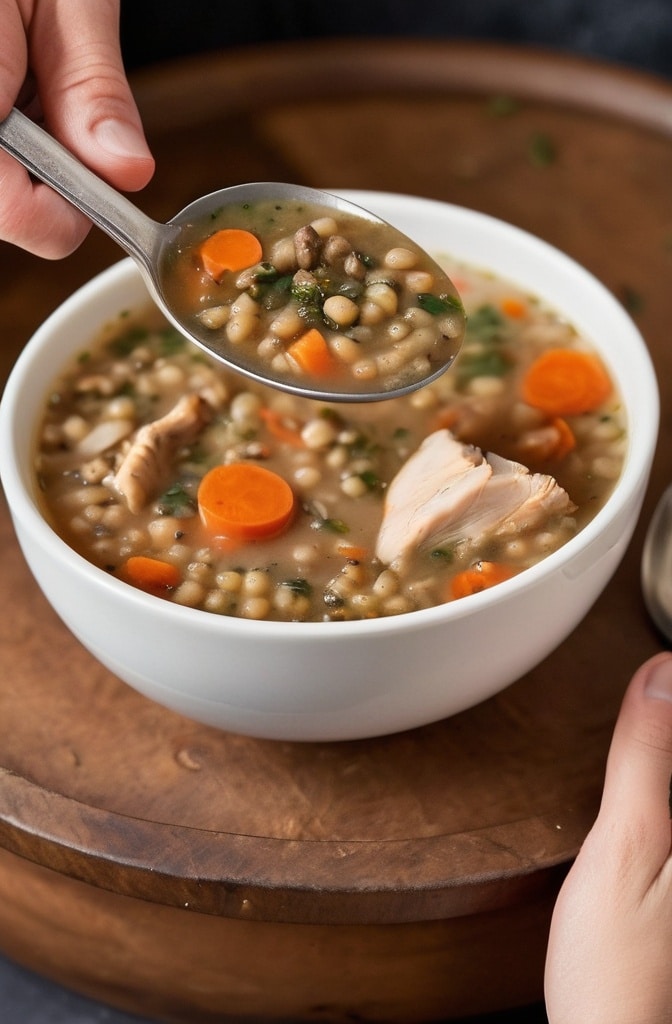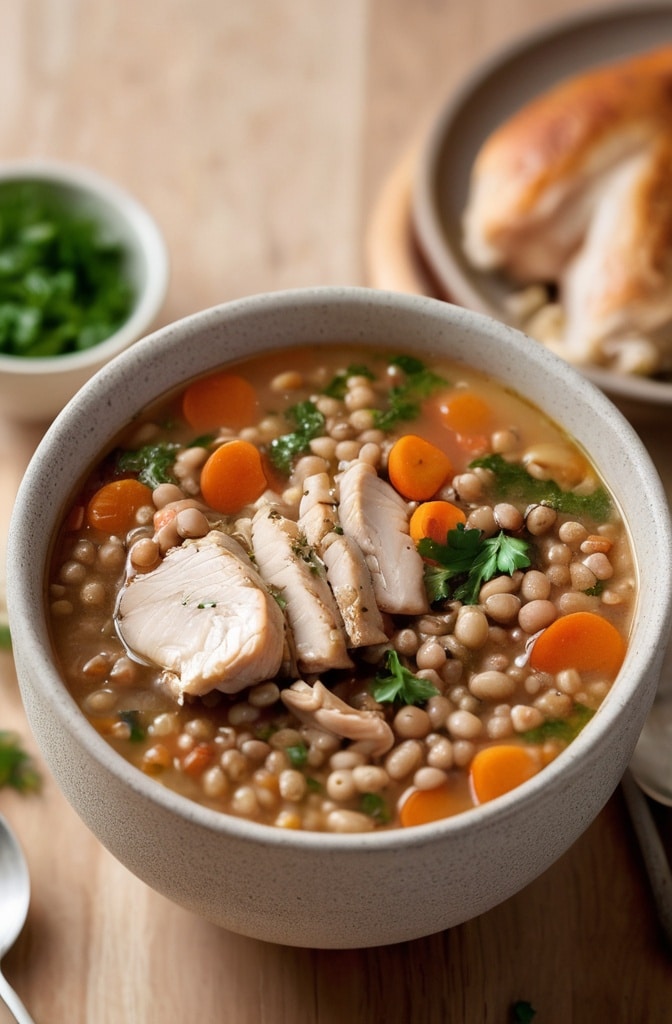I’ll never forget the day I discovered the transformative power of chicken lentil soup. Battling the worst flu of my life, shivering under three blankets, a neighbor appeared at my door with a steaming container of what she simply called “grandma’s cure-all.” The fragrant steam carried hints of roasted chicken, earthy lentils, and a complex spice profile I couldn’t quite place. One spoonful and I swear my sinuses cleared by the next morning, I felt human again. Was it placebo effect? Possibly. But I’ve been obsessed with perfecting chicken lentil soup ever since.
Chicken lentil soup represents the beautiful convergence of economy, nutrition, and exquisite flavor that defies its humble ingredients. It’s what I call a “universal soul food”—virtually every culture has their version, from Moroccan harira to Indian mulligatawny to the rustic French preparations featuring Le Puy lentils. The combination of protein-rich chicken, fiber-packed lentils, and a symphony of aromatics creates a dish that’s both deeply satisfying and remarkably nutritious. The beauty lies in its versatillity—endlessly adaptable to seasonal ingredients, pantry constraints, or dietary preferences.
Understanding the Essence of Chicken Lentil Soup
The magic of an exceptional chicken lentil soup comes from understanding the roles of each component. The chicken provides savory depth and satisfying protein. The lentils offer earthy richness, structural integrity, and remarkable nutritional density. The aromatics and spices create the soup’s personality—its cultural identity and aromatic profile. Master these fundamentals, and you’ll create soup that transcends the ordinary.
What distinguishes a truly memorible chicken lentil soup isn’t fancy technique but rather patience and attention to detail. The layering of flavors, the proper cooking of lentils, and the balance of textures separate mediocre attempts from sublime results. Let’s unpack the elements that make this deceptively simple dish extraordinary.
Ingredients & Substitutions
For the base:
- 2 tablespoons olive oil (extra virgin preferred)
- 1 large onion, finely diced
- 2 medium carrots, diced
- 2 celery stalks, diced
- 4 garlic cloves, minced
- 1 tablespoon tomato paste
- 1 bay leaf
- 1 teaspoon fresh thyme (or ½ teaspoon dried)
- ½ teaspoon ground cumin
- ¼ teaspoon ground coriander
- 8 cups chicken stock (homemade preferred)
- 1 cup dry lentils (French green, brown, or black beluga)
- Salt and freshly ground black pepper
For the chicken:
- 1.5 pounds bone-in, skin-on chicken thighs
- 1 tablespoon olive oil
- Salt and freshly ground black pepper
- ½ teaspoon paprika (smoked or sweet)
For finishing:
- 2 tablespoons freshly squeezed lemon juice
- ¼ cup fresh herbs (parsley, cilantro, or dill), chopped
- Extra virgin olive oil, for drizzling
Let’s talk lentil selection, cuz this choice significantly impacts your soup’s character. French green (Le Puy) lentils maintain their shape beautifully during cooking, offering pleasant bite and texture. Brown lentils cook quicker and break down more, creating a thicker, heartier soup. Red lentils disintegrate completely, producing a smoother, more stew-like consistency. For those avoiding legumes entirely, cauliflower rice or diced turnips can provide similar textural elements with different nutritional profiles.
The choice between bone-in and boneless chicken dramatically affects flavor development. Bone-in pieces contribute significantly more depth and richness to the broth. If dietary restrictions demand plant-based alternatives, meaty mushrooms (particularly oyster or king oyster varieties) sautéed with smoked paprika and soy sauce can provide surprisingly chicken-like umami depth.
Fresh herbs transform this soup from satisfying to spectacular. While dried herbs work in a pinch, nothing replaces the brightness and aromatic complexity of fresh herbs added in the final minutes of cooking. Hardy herbs like rosemary and thyme can withstand longer cooking, while delicate cilantro, parsley, and dill should be reserved for garnishing.
Step-by-Step Instructions

Preparing the Chicken
First, let’s coax maximum flavor from our chicken. Pat those thighs thoroughly dry with paper towels—this step is non-negotiable if you want proper browning. Season generously with salt, pepper, and paprika on both sides.
Heat olive oil in a Dutch oven or heavy-bottomed pot over medium-high heat until shimmering but not smoking. Place chicken skin-side down and resist the urge to move it for at least 5 minutes. We’re after that gorgeous golden crust which translates directly to flavor. Once properly seared on both sides (about 4-5 minutes per side), remove the chicken to a plate. Don’t worry about cooking it through—it’ll finish in the soup later.
The most common mistake home cooks make is crowding the pan. If necessary, sear in batches—overcrowding leads to steaming rather than browning. Another frequent error is under-seasoning. Remember that soup requires assertive seasoning, as flavors dilute in liquid.
Building the Aromatic Base
This is where patience truly pays dividents. Using the same pot with all those gorgeous chicken drippings, reduce heat to medium and add your diced onion, carrots, and celery. Season with a pinch of salt to help vegetables release their moisture. Cook until the onions are translucent and just beginning to caramelize at the edges, about 7-8 minutes.
Add the minced garlic and cook just until fragrant, about 30 seconds—burned garlic will ruin your soup with bitter notes. Stir in tomato paste and allow it to caramelize slightly, about 1-2 minutes. This step, often overlooked, develops remarkable depth through the Maillard reaction. Now add your bay leaf, thyme, cumin, and coriander, stirring to coat the vegetables and blooming the spices in the hot fat.
For variations that completely transform the character of your soup, consider these spice alternatives: Moroccan-inspired with ras el hanout, cinnamon, and harissa; Mediterranean with oregano, lemon zest, and olives; or Indian-inspired with garam masala, turmeric, and ginger.
Adding Lentils and Liquid
Now’s the time for your lentils to join the party. Add them to the pot and stir to coat with the aromatic mixture. This brief “toasting” of the lentils in fat before adding liquid enhances their nutty flavor. After about 1 minute, pour in your chicken stock.
A quick word on lentil preparation contrary to popular belief, not all lentils need soaking. French green and black lentils can go straight into the pot after rinsing and picking through for stones. However, brown lentils benefit from a 30-minute soak, which promotes even cooking. Red lentils require no soaking and cook much faster than their counterparts.
Return the chicken to the pot, nestling it into the liquid. Bring everything to a gentle boil, then reduce heat to maintain a slow simmer. Cover partially with a lid and cook for about 25-30 minutes, until lentils are tender but still maintain some structure. The exact timing will depend on your lentil variety.
Finishing the Soup
Once the lentils have reached desired tenderness, remove the chicken pieces. When cool enough to handle, remove and discard the skin, then shred the meat into bite-sized pieces using two forks. Return the shredded chicken to the pot.
Now comes the crucial balancing act: taste and adjust seasoning. Most soups need more salt than you might initially think, but add incrementally. Stir in the fresh lemon juice—this brightening acid is what makes flavors pop and prevents the soup from tasting flat or dull. Remove the bay leaf before serving.
Off the heat, stir in most of your chopped fresh herbs, reserving some for garnish. For a richer, more luxurious finish, you might stir in a tablespoon of butter or a swirl of cream though purists might consider this gilding the lily.
Cooking Techniques & Science
Understanding the science behind this soup elevates it from good to exceptional. The Maillard reaction that beautiful browning we achieve when searing the chicken and caramelizing vegetables creates hundreds of new flavor compounds. These compounds introduce complexity that simply cannot be achieved through boiling or steaming alone.
Lentils contain both soluble and insoluble fiber, which behave differently during cooking. The soluble fiber slightly thickens the broth, while the insoluble fiber maintains texture. This is why properly cooked lentils still have bite while simultaneously enriching the surrounding liquid. Overcooking destroys this beautiful balance, turning everything to mush.
For texture control, many professional kitchens cook lentils separately from the soup base, adding them only in the final stages. This prevents the all-too-common problem of perfect chicken but mushy lentils (or perfectly tender lentils but dry chicken). If you’re after absolute technical perfection, this two-pot method yields superior results, particularly with delicate red lentils.
The role of acid in soup cannot be overstated. Without that finishing touch of lemon juice (or vinegar in some variations), flavors remain flat and one-dimensional. Acid brightens flavors much like salt does, but without increasing sodium content. It’s particularly important in legume-based soups, which can otherwise taste rather dull and heavy.
Serving & Pairing Suggestions
Presentation elevates humble soup to restaurant-worthy status. Serve chicken lentil soup in wide, shallow bowls that showcase its components rather than deep bowls that obscure its beauty. Drizzle each portion with your best extra virgin olive oil that grassy, peppery finish transforms the eating experience. Scatter the reserved fresh herbs atop each serving, and consider a small spoonful of thick yogurt or crème fraîche for creamy contrast.
Accompaniments should complement without overwhelming. A slice of rustic sourdough bread, lightly toasted and rubbed with garlic, makes the perfect edible utensil. For a complete meal, a simple side salad of bitter greens dressed with lemon and olive oil provides textural contrast and palate-cleansing freshness.
Wine pairing depends somewut on your soup’s flavor profile. For herbal Mediterranean versions, a crisp Vermentino or unoaked Chardonnay works beautifully. Spicier variations call for off-dry Riesling or Gewürztraminer. If you’ve gone the smoky paprika route, a light Spanish red like Garnacha makes a lovely companion.
For make-ahead convenience, this soup actually improves with age up to a point. The flavors meld and deepen overnight, making it perfect for batch cooking. Store in the refrigerator for up to 4 days or freeze for up to 3 months. When reheating, you may need to add additional stock or water as the lentils continue to absorb liquid even in storage.
Beyond the Basic Recipe

Once you’ve mastered the fundamental technique, the variations become endless. Consider these professional-level adaptations:
Pressure Cooker Conversion: Reduce stock to 6 cups and cook under high pressure for 10 minutes with natural release. The intensified environment develops flavor in a fraction of the time.
Smoked Chicken Variation: Substitute smoked chicken thighs for an entirely different flavor profile that eliminates the searing step while adding remarkable depth.
Vegetarian Adaptation: Replace chicken with roasted mushrooms and chicken stock with mushroom or vegetable stock enhanced with kombu seaweed for umami depth.
Spice Route Variations: Create signature versions by adapting the spice profile: North African (harissa, preserved lemon), Indian (garam masala, coconut milk), Mediterranean (oregano, lemon, olives), or Persian (dried lime, saffron, mint).
The true mastery comes not from slavishly following recipes but understanding the underlying principles that make this soup work. The balance of protein to legume, the layering of aromatics, the proper cooking of each component, and the final brightening with acid and fresh herbs these fundamentals transcend specific ingredients.
Conclusion
Chicken lentil soup stands as testament to culinary alchemy—transforming humble ingredients into something far greater than their individual contributions. It represents the beautiful economy of traditional cooking, where nothing is wasted and every element serves multiple purposes. The chicken provides both protein and flavor base. The lentils offer sustenance and structural integrity. The aromatics and spices create the cultural context and personality.
What elevates your soup from adequate to memorable isn’t exotic ingredients or complicated techniques, but rather attentiveness to detail. Proper browning. Thoughtful seasoning. Correct cooking times. Balancing acidity. These seemingly small considerations compound into remarkable results.
Whether you’re cooking to nourish a family, impress dinner guests, meal prep for a busy week, or simply comfort yourself on a cold evening, chicken lentil soup delivers on all fronts. It’s economical yet luxurious, nutritious yet craveable, simple yet nuanced. Master this dish, and you’ve mastered a culinary fundamental that spans cultures, generations, and occasions.
FAQs
My lentils are still crunchy but my chicken is overcooked. What went wrong?
This common issue typically stems from lentil age or variety. Older lentils take significantly longer to cook. For foolproof results, consider cooking chicken and lentils separately, then combining them. Remove chicken once it reaches 165°F internal temperature, continue cooking lentils until tender, then recombine. Alternatively, use boneless chicken pieces added later in the cooking process.
Can I use a slow cooker for chicken lentil soup?
Absolutely, with modifications. First, sear the chicken and sauté aromatics on the stovetop. Transfer to a slow cooker along with remaining ingredients except herbs and lemon juice. Cook on low for 6-8 hours or high for 3-4 hours. Remove chicken, shred, and return to the pot along with herbs and lemon juice in the final 30 minutes. Note that slow cookers intensify some herb flavors, so adjust accordingly.
My soup is too thin/too thick. How can I adjust the consistency?
For thin soup, either simmer uncovered to reduce, or create a slurry of 1 tablespoon cornstarch mixed with 2 tablespoons cold water, then stir into simmering soup. For overly thick soup, add additional stock or water in small increments. Remember that refrigerated leftovers will thicken significantly as lentils continue absorbing liquid overnight.
How can I make this soup more substantial for a main course?
Add hearty greens like kale, chard, or spinach in the final minutes of cooking. For additional protein and texture, stir in cooked quinoa or farro. To make it more stew-like, double the chicken and reduce liquid by about 25%. For a one-pot meal approach, add diced potato or sweet potato along with the lentils.
What’s the best way to store and reheat this soup?
Cool soup completely before refrigerating (up to 4 days) or freezing (up to 3 months). When freezing, leave at least one inch of headspace in containers to allow for expansion. Thaw frozen soup overnight in the refrigerator. Reheat gently on the stovetop over medium-low heat, stirring occasionally and adding water or stock if needed to restore original consistency. Refresh flavors with a squeeze of fresh lemon and additional herbs.

